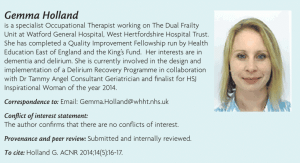

People in need of our services need staff who offer clinical expert knowledge, skills and passion backed up by experience and research Good clinical leadership of our services is self evidently important in ensuring the patient experience is as good as it can be.
There are currently in the UK National Health Service a number of leadership training schemes. In the East of England scheme which is entering a third year of operation, a recent Quality Improvement programme has brought together a wide range of clinicians and administrators to be “Quality Improvement Fellows”.i Fellows had the chance to benefit from mentors and training provided by staff at the King’s Fund. I heartily recommend colleagues to look for similar opportunities.ii
In one of the sessions of this training programme participants enjoyed a moment to reflect on the art of story-telling. Graphic designer Graham Ogilvie was present, drawing simple cartoons of the messages conveyed by participants who had been asked to turn their quality improvement projects into a story. Participants were encouraged to use the form of a story, to think about characterisation, heroes and villains, start and ending, and other ingredients. I considered that Gemma has done this in such a compassionate and warm way, clearly demonstrating the point of Dementia Friendly wards.
There is a broader point: as scientist-practitioners we need to ask ourselves how we should best translate findings from projects (service improvement, audits or research) into documents that motivate action. Have we shared our learning in a way that ensures widest possible benefit?
Sometimes translation of research can be done in ways that are very familiar to us all, and it is perhaps not a fairy story to imagine that Services can improve through leadership such as is provided by people like Gemma. Gemma’s story provides an illustration of this because we are readily drawn into narratives. I wonder if you find yourself thinking about what you could do differently as a result of reading this?
Perhaps a different style of article to those usually published in this journal, I was really interested to note how it has been possible to allude to a rich literature in a short space. But most of all, I found this story to make for a compelling read and I hope our regular readers do too.
i. https://www.eoedeanery.nhs.uk/page.php?page_id=2781
ii. http://www.kingsfund.org.uk/leadership

John and Mary had been married for 52 years, they lived a happy and fulfilled life together, they had raised their family, John had worked hard as an engineer travelling around the country and now they were enjoying their retirement together. John was extremely active, he enjoyed spending time with his family, working in his shed completing DIY tasks and maintaining his vegetable filled beautiful garden.8,11 Over a period of time a dark fog began to envelop John. He would be part way fixing the tyre on his bike and he would forget what he needed to do next.7,8 He began to get muddled with what day it was and forget the word that he wanted to say in conversation with his grandchildren.7 John began to withdraw in himself, he felt invisible, he felt his family would talk about him as though he was no longer there, he lost his appetite, he refused to drink, he would wear the same clothes for days and would stare out onto his beautiful garden lost in his own world.4,7,8 The fog deepened, John began a downward spiral, falling deeper and deeper into the unknown.4,8,15 Eventually John found himself trapped in a dungeon, guarded by dragons and tied up in chains of stigma, his voice and identity lost.4,15 Scared and confused by his surroundings John looked for ways to escape but the dragons kept pulling him back.5 John tried to fight them, he kicked and hit, but the dragons overpowered him with potions that made him tired and sleepy.3
One day John woke from his sleep to find a beautifully weaved basket full of items that made up his identity – a photo of his and Mary’s wedding day, the boiler suit he loved to wear when outside working and his gardening book that he loved to flick through whilst having a cup of tea in the morning.2,8,10,11,15 As John picked each item from the basket a calmness descended upon him and before his eyes an angel appeared – a Dr Angel – who granted him three wishes.6,10,11

John’s first wish was to get his voice back – he no longer wanted to be invisible and he wished his thoughts and beliefs could be heard.3,8,11,13 His second was to be able to do the activities he previously loved to do, to have a role, and feel useful and needed.7,8 His third wish was to have the opportunity to go home to his lovely wife and familiar surroundings.
Suddenly the fog began to lift and the dungeon was no longer a dungeon, it had transformed into a dementia friendly ward.4 The environment was a large space with clearly visible signs to direct to the toilet. John was encouraged to walk around. He had access to a garden and fresh air.4,5,7,13,15 The dragons became health professionals that would call John by his name, listen to his wishes and act upon his request for support of his care needs.4,7,12 They communicated with John with an improved level of respect and were mindful that John may find complex sentences difficult to process.7,13,14 They were patient and understanding when John struggled to clearly express himself, but gave him the opportunity to have his say.2,7,12 John was enabled to complete his own personal care tasks and given support when needed.8,13 They encouraged him to dress in his own clothes and worked with John at a level he was able to understand. John became involved in ward activities. His skills in DIY were actively encouraged to help build the raised flower beds in the garden and care for the many herbs and flowers donated to the ward.3,5-7,10-13 Alongside the increase in his activity, John’s appetite began to return and when he woke one morning craving a bacon and egg sandwich, one was sought after.1,8 Mealtimes were encouraged to be social events where all sat at a brightly coloured table set for the gentlemen in the bay.5,11 Drinks were offered throughout the day and snacks of sandwiches, cakes or fruit were freely available to pick at when peckish.6,7
John and Mary were included in the discussions of his ongoing medical care and his voice was loud and clearly heard when planning his discharge from the ward.3,6 John was given the opportunity to go home, with 24 hour enabling support that reduced over a 21 day pathway. John and Mary were involved in the process of tailoring the care to enable and support John’s needs, re-establish his routine and set himself goals.3,7,9,13 Mary was given support in managing the times when John became frustrated with his slow recovery and difficulty in understanding what had happened (that it had seemed like he was living in a nightmare).3,14,15 For the 21 days the carer, Mary and John could seek advice and support over the phone, and home visits took place to refresh John’s goals and to see his functional improvement in his home environment.7,8 The carer encouraged John to engage in the activities he previously enjoyed.2 Things began to settle and one day into the second week Mary looked out of the kitchen window and began to smile at the sight of John and the carer caterpillar hunting around the vegetable garden, sneakily eating the blackberries until their tummies ached.2,8,10,13 The pathway provided education to Mary on the ways to reduce the risk of the dungeon and dragons returning again. By monitoring John’s medication compliance, nutritional and fluid intake, bowel and bladder habits as well as being aware of changes in John’s behaviour.3,4,7,14,15 Midway through the pathway a mental and physical health review in ambulatory care signed John off from the acute hospital and he was referred on for diagnosis, advice and support on dementia.14 John no longer felt invisible and alone. He began to realise that this was going to be a new stage in his and Mary’s journey together.2,7,8 For John the fog was still there, but it was lighter now and the sunshine began to break through.4,8
- Bruton A, Lipp A, McKenzie G. Graduate foundation scheme with a focus on dignity and older adults. Nursing Management -2012;18(9):20-5.
- Carr TJ, Hicks-Moore S, Montgomery P. What’s so big about the ‘little things’: A phenomenological inquiry into the meaning of spiritual care in dementia. Dementia 2011;10(3):399-414.
- Clissett P, Porock D, Harwood RH, Gladman JRF. Experiences of family carers of older people with mental health problems in the acute general hospital: a qualitative study. Journal of Advanced Nursing, 2013;69(12):2707-16.
- Dat J, Higgins I, Keatings.D. Orientation Strategies during delirium:are they helpful? Journal of Clinical Nursing 2011;20:3285-94.
- Dechamps A, Alban R, Jen J, Decamps A, Traissac T, Dehail P. Individualized Cognition-Action intervention to prevent behavioral disturbances and functional decline in institutionalized older adults: a randomized pilot trial. International Journal of Geriatric Psychiatry 2010;25(8):850-60.
- Galvin JE, Kuntemeier B, Al-Hammadi N, Germino J, Murphy-White M, McGillick J. ‘Dementia-friendly Hospitals: Care not Crisis’: An Educational Program Designed to Improve the Care of the Hospitalized Patient With Dementia. Alzheimer Disease And Associated Disorders 2010;24(4):372-9.
- Heath H, Sturdy D, Wilcock G. Improving quality of care for people with dementia in general hospitals. Nursing Older People 2010:1-16.
- Kitwood T. The experience of dementia. Age and Mental Health 1997;1:1:13-22.
- Landi F, Liperoti R, Bernabei R. Postacute Rehabilitation in Cognitively Impaired Patients: Comprehensive Assessment and Tailored Interventions. Journal of the American Medical Directors Association 2011;12(6):395-7.
- Rylatt P. The benefits of creative therapy for people with dementia. Nursing Standard (Royal College Of Nursing (Great Britain): 1987) 2012;26(33):42-7.
- Scott, A. Working in partnership with patients and families on a dementia assessment unit to improve care. Foundation of Nursing Studies: Developing Practice Improving Care Dissemination Series 2011;6(8):1p.
- Storey E, Thomas B. Use patience with patients with dementia. Advance for Physical Therapy & Rehab Medicine 2010;21(4):56-56.
- Teitelman J, Raber C, Watts J. The power of the social environment in motivating persons with dementia to engage in occupation: qualitative findings. Physical & Occupational Therapy in Geriatrics, 2010;28(4):321-33.
- Department of Health. Living Well with Dementia: A National Dementia Strategy. Department of Health. 2009.
- National Institute for Health and Clinical Excellence. Delirium: Diagnosis, Prevention and Management. NICE clinical guideline 103 2010.
ACNR 2014;V14(5): 16-17. Online 26/10/14